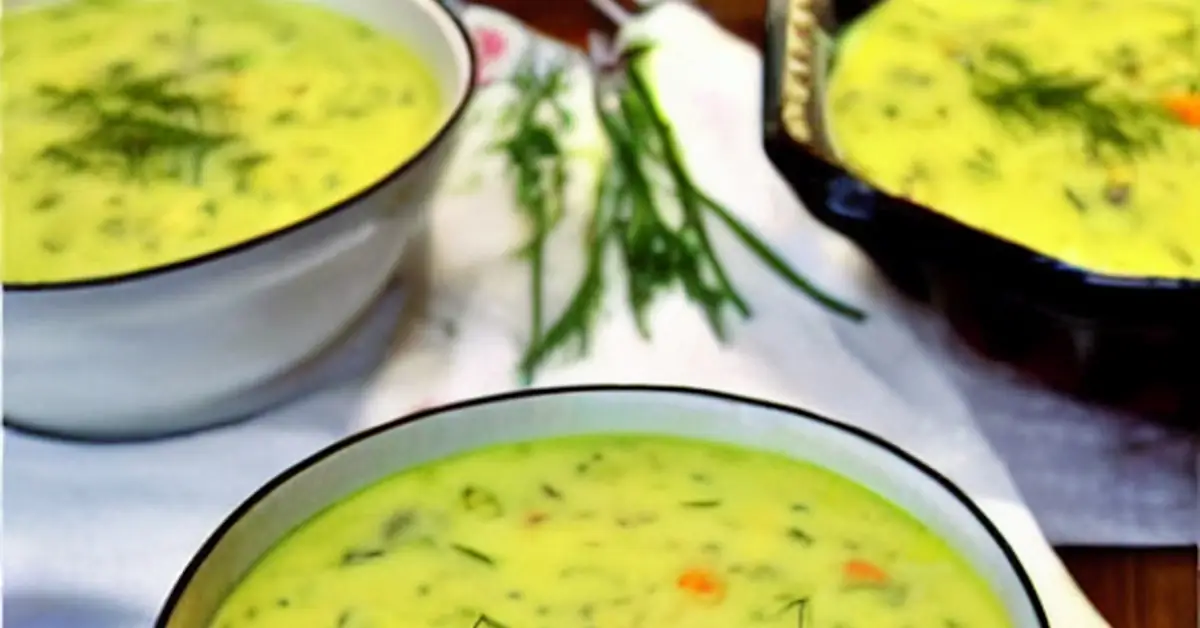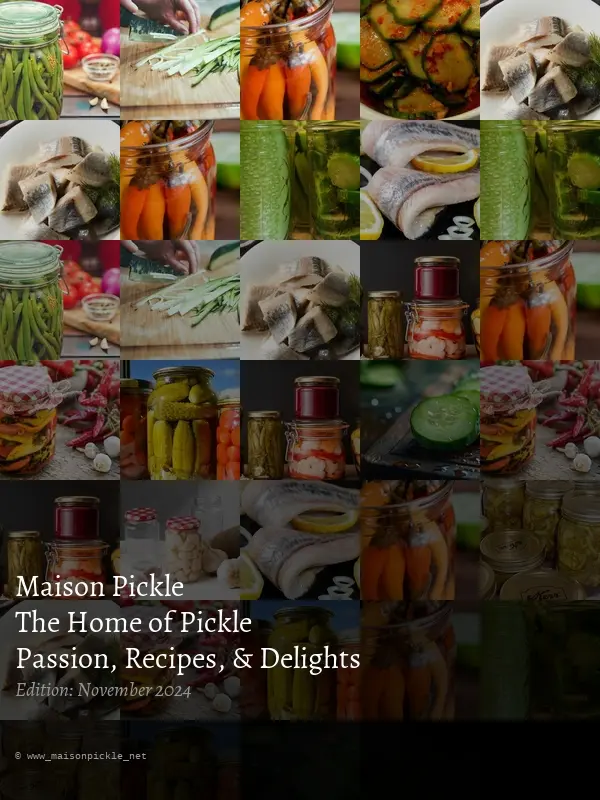Dill Pickle Soup: A Comforting Culinary Delight
Dill pickle soup, also known as zupa ogórkowa in Polish cuisine, is a unique and comforting dish celebrated for its creamy texture and tangy flavor. This comprehensive guide delves into its rich history, essential ingredients, detailed preparation methods, exciting variations, and notable health benefits, ensuring you're equipped to create this culinary masterpiece.
History of Dill Pickle Soup: A Journey Through Time
Originating in the heart of Eastern European cuisine, particularly within the rich culinary traditions of Poland, dill pickle soup reflects a time-honored practice of preserving vegetables through pickling, a necessity before the advent of widespread refrigeration. This soup embodies the very essence of comfort food, skillfully utilizing simple, readily available ingredients to craft a hearty and soul-warming dish. Its distinctive taste profile, characterized by its balanced tanginess and creamy texture, has propelled its popularity far beyond its Eastern European origins, captivating palates globally.
The historical context of zupa ogórkowa highlights its deep connection to resourcefulness and practicality. Pickling was crucial for preserving vegetables through the long winter months, ensuring a consistent supply of vital nutrients. Dill pickle soup, therefore, became more than just a meal; it represented a testament to culinary ingenuity and a resourceful approach to utilizing readily available ingredients. Its enduring popularity speaks to its ability to transcend time and continue to resonate with modern palates seeking both flavor and nourishment.
The evolution of dill pickle soup has seen subtle variations across different regions and families, each adding its own unique spin on this classic recipe. However, the core elements remain constant, emphasizing the simplicity and effectiveness of the fundamental ingredients. This adaptability is a testament to the soup's enduring appeal and its ability to evolve alongside culinary trends while still maintaining its traditional heart.
Ingredients: The Building Blocks of Flavor
The undeniable appeal of dill pickle soup lies in its surprisingly straightforward yet deeply flavorful ingredients. The careful selection and combination of these components contribute to the soup's unique character and delightful taste. Let's explore each ingredient in detail:
- Dill Pickles: The undisputed star of the show, dill pickles provide the signature tangy and briny flavor that defines this soup. Using high-quality, crisp pickles is paramount to achieving the best results. The type of pickle, whether it's a classic dill, bread and butter, or even a spicy dill, will influence the final taste of the soup, allowing for a degree of customization.
- Pickle Juice: Often overlooked, the pickle juice adds a crucial layer of depth and tartness. It contributes the signature briny flavor and enhances the overall balance of the soup. Don't discard this essential element; it's a flavor powerhouse.
- Potatoes: The choice of potato significantly impacts the soup's texture and flavor. Yukon gold or russet potatoes are excellent choices, offering a creamy texture and effectively absorbing the flavors of the other ingredients. Their starchy nature helps to thicken the soup naturally.
- Onion: The onion forms a savory base, providing a gentle sweetness and depth to the broth. Yellow or sweet onions are ideal choices due to their mild flavor, which complements the other ingredients without overpowering them. The sautéed onion contributes significantly to the overall aroma of the soup.
- Carrots and Celery: These vegetables add sweetness and further enrich the depth of the broth. Carrots contribute a touch of natural sweetness, while celery adds a subtle earthy note and a pleasant textural contrast. Their combined contribution is often underestimated, yet vital to the overall balance of the soup.
- Garlic: A small amount of garlic infuses the soup with an aromatic richness and depth. Minced garlic is often preferred, as it readily distributes its flavor throughout the soup. The use of garlic should be adjusted according to individual preferences.
- Broth: The choice of broth—chicken or vegetable—forms the very foundation of the soup. Chicken broth adds a savory richness, while vegetable broth maintains a lighter, vegetarian-friendly profile. The quality of the broth will greatly impact the overall flavor of the finished soup.
- Sour Cream: Sour cream lends the soup its signature creamy texture and helps to balance the acidity of the pickles and pickle juice. It adds richness and a subtle tanginess that enhances, rather than masks, the other flavors.
- Fresh Dill: Adding fresh dill elevates the flavor profile, enhancing the dill notes and adding a touch of freshness. The vibrant green color also adds visual appeal. The amount of fresh dill can be adjusted to taste, providing flexibility in terms of intensity.
Basic Preparation Method: A Step-by-Step Guide
Creating delicious dill pickle soup is surprisingly straightforward, requiring less than an hour of active preparation time. Follow these steps for a consistently satisfying result:
- Sauté Aromatics: Begin by melting butter or heating oil in a large pot over medium heat. Add the diced onions, carrots, and celery, and sauté until they become softened, approximately 5-7 minutes. This step allows the vegetables to release their flavors and create a fragrant base for the soup.
- Add Garlic: Stir in the minced garlic and cook for another minute until it becomes fragrant. Be careful not to burn the garlic, as this can impart a bitter taste.
- Incorporate Potatoes and Broth: Add the cubed potatoes and your chosen broth (chicken or vegetable) to the pot. Bring the mixture to a boil, then reduce the heat to low and simmer until the potatoes are tender, approximately 15-20 minutes. This ensures the potatoes are cooked through and ready to absorb the other flavors.
- Mix in Pickles and Juice: Stir in the chopped dill pickles and pickle juice. Continue to simmer for another 5 minutes to allow the flavors to meld together. This step infuses the soup with the signature tangy and briny flavor of the pickles.
- Creamy Finish: For an extra creamy texture, whisk together sour cream and a small amount of flour (optional) in a separate bowl. This creates a slurry that helps thicken the soup and prevents the sour cream from curdling. Temper the sour cream mixture by gradually adding a small amount of hot broth to it before stirring it into the soup. This prevents the sour cream from curdling when added directly to the hot soup.
- Season and Serve: Season the soup with salt and pepper to taste, and stir in the fresh dill. Taste and adjust seasonings as needed. Serve the soup hot, garnished with extra fresh dill if desired. It pairs perfectly with crusty bread, crackers, or a side salad.
Variations of Dill Pickle Soup: Expanding Your Culinary Horizons
While the basic recipe provides a delicious foundation, the beauty of dill pickle soup lies in its adaptability. Numerous variations exist, each adding unique twists to the classic flavor profile. Experiment with these options to discover your personal favorite:
- Polish Style with Ham or Smoked Meats: Elevate the richness and smokiness of the soup by adding diced ham, bacon, or other smoked meats during the simmering stage. The smoky flavors complement the tangy pickles beautifully, creating a hearty and satisfying meal.
- Vegan Version: Create a delicious and entirely vegan adaptation by substituting the sour cream with a plant-based alternative like coconut cream or cashew cream. Use vegetable broth as the base, and omit any meat products. This variation retains the creamy texture and tangy flavor while remaining entirely plant-based.
- Spicy Dill Pickle Soup: Add a kick of heat by incorporating crushed red pepper flakes or diced jalapeños during the sautéing stage or towards the end of the cooking process. This adds a welcome layer of spice and complexity, appealing to those who enjoy a bit of heat.
- Creamy vs. Brothy Consistency: Adjust the amount of sour cream to achieve your desired consistency. For a creamier soup, use more sour cream. For a lighter, brothy soup, use less. This level of control allows you to customize the soup to your preferences.
- Adding other vegetables: Experiment with other vegetables like green beans, peas, or corn to add different flavors and textures to the soup. The possibilities are endless, allowing you to create a unique and personalized version each time.
- Adding herbs: Incorporate other herbs besides dill, such as parsley, thyme, or chives, to enhance the flavor profile and create a more complex taste. These herbs complement the dill without overpowering it, adding subtle nuances to the overall flavor.
Health Benefits of Dill Pickle Soup: Nourishment and Flavor Combined
Beyond its delightful flavor, dill pickle soup offers several unexpected health benefits. Its nutritional profile and the inclusion of fermented ingredients make it a surprisingly healthy choice:
- Low-Calorie Option: Primarily composed of vegetables and broth, it's a filling and satisfying meal without being overly caloric. This makes it an excellent option for those watching their calorie intake or seeking lighter meal choices.
- Probiotics from Pickles: The fermented pickles are a source of beneficial probiotics, which support gut health and contribute to a healthy digestive system. These probiotics are vital for maintaining a balanced gut microbiome, aiding in digestion and overall well-being.
- Rich in Vitamins and Minerals: The various vegetables present in the soup, such as potatoes, carrots, and celery, contribute a significant amount of vitamins A and C, potassium, and dietary fiber. These nutrients are essential for maintaining a healthy immune system and overall well-being.
- Hydration: The broth base provides a significant amount of hydration, particularly important for maintaining good health and overall well-being. Especially beneficial during colder months when fluid intake tends to decrease.
Serving Suggestions: Elevating the Dill Pickle Soup Experience
To fully enjoy the experience of dill pickle soup, consider these serving suggestions to enhance its flavors and presentation:
- Crusty Bread: Serve the soup with a side of crusty bread, such as sourdough or rye, for dipping. The contrasting textures and flavors create a delightful culinary experience.
- Salads: A light salad of fresh greens with a simple vinaigrette complements the richness of the soup, offering a refreshing contrast in both texture and flavor.
- Cheesy Garlic Bread: For an indulgent treat, pair the soup with cheesy garlic bread. The savory and cheesy flavors add a layer of richness and complement the tanginess of the soup.
- Sauerkraut: A small side serving of sauerkraut adds an extra layer of fermented flavor and texture, complementing the overall briny nature of the soup.
- Pickled Vegetables: Adding a small bowl of pickled vegetables, such as pickled onions or peppers, enhances the overall theme and provides another dimension to the tangy flavors.
Conclusion: A Culinary Journey Worth Embarking On
Dill pickle soup is more than just a simple dish; it’s a flavorful and comforting culinary experience that seamlessly blends simplicity with complexity. Its versatility and adaptability make it a perfect choice for any occasion, whether it’s a casual weeknight meal or a more formal gathering. The relatively short preparation time, coupled with the potential for creative variations, makes it an ideal choice for both novice and experienced cooks alike. Its rich history, wholesome ingredients, and surprising health benefits make dill pickle soup a truly remarkable culinary journey worth embarking on.




